

Round Table. History[edit] Though the Round Table itself is not mentioned until Wace, the concept of Arthur having a marvelous court made up of many prominent warriors is much older.

Geoffrey of Monmouth says that after establishing peace throughout Britain, Arthur "increased his personal entourage by inviting very distinguished men from far-distant kingdoms to join it. "[3] The code of chivalry so important in later romance figures in as well, as Geoffrey says Arthur established "such a code of courtliness in his household that he inspired peoples living far away to imitate him. Later development[edit] Tristan. Tristan legend cycle[edit] Tristan makes his first medieval appearance in the early twelfth century in Celtic mythology/Celtic folklore circulating in the north of France and the Kingdom of Brittany, which had close ancestral and cultural links with Cornwall by way of the ancient British kingdom of Dumnonia, as made clear in the story itself, and the closely related Cornish and Breton languages.
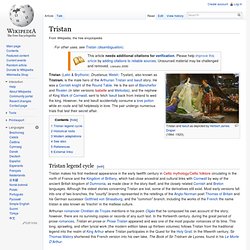
Sir Ector. Sir Kay showeth the mystic sword unto Sir Ector, by Howard Pyle from The Story of King Arthur and His Knights. (1903) Sir Ector /ˈɛktɵr/, sometimes Hector, Antor, or Ectorius, is the father of Sir Kay and the foster father of King Arthur in the Arthurian legend.
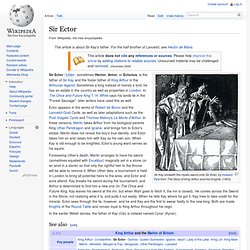
Sometimes a king instead of merely a lord, he has an estate in the country as well as properties in London. In The Once and Future King T. H. White says his lands lie in the "Forest Sauvage"; later writers have used this as well. Ector appears in the works of Robert de Boron and the Lancelot-Grail Cycle, as well as later adaptations such as the Post-Vulgate Cycle and Thomas Malory's Le Morte d'Arthur.
Foreseeing Uther's death, Merlin arranges to have his sword (sometimes equated with Excalibur) magically set in a stone (or an anvil in a stone) so that only the rightful heir to the throne will be able to remove it. Sir Kay. Sir Kay breaketh his sword at ye Tournament, by Howard Pyle from The Story of King Arthur and His Knights. (1903) Role in Welsh tradition[edit] Cai or Cei is one of the earliest characters to be associated with the Arthurian cycle, appearing in a number of early Welsh texts, including Culhwch ac Olwen, Geraint fab Erbin, Iarlles y Ffynnon, Peredur fab Efrawg, Breuddwyd Rhonabwy, Pa Gur yv y Porthur and the Welsh Triads.
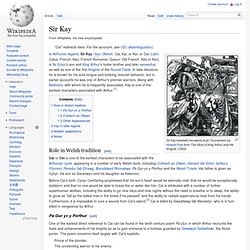
His father is given as Cynyr, his son as Garanwyn and his daughter as Kelemon. Before Cai's birth, Cynyr Ceinfarfog prophesied that his son's heart would be eternally cold, that he would be exceptionally stubborn and that no one would be able to brave fire or water like him. Galahad. Sir Galahad (/ˈɡæləhæd/; Middle Welsh: Gwalchavad, sometimes referred to as Galeas /ɡəˈliːəs/ or Galath /ˈɡæləθ/), in Arthurian legend, is a knight of King Arthur's Round Table and one of the three achievers of the Holy Grail.
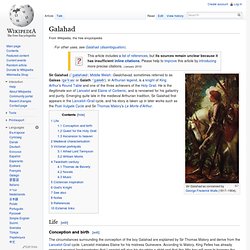
He is the illegitimate son of Lancelot and Elaine of Corbenic, and is renowned for his gallantry and purity. Emerging quite late in the medieval Arthurian tradition, Sir Galahad first appears in the Lancelot–Grail cycle, and his story is taken up in later works such as the Post-Vulgate Cycle and Sir Thomas Malory's Le Morte d'Arthur. Life[edit] Conception and birth[edit] The circumstances surrounding the conception of the boy Galahad are explained by Sir Thomas Malory and derive from the Lancelot-Grail cycle. According to the thirteenth century Old French Prose Lancelot (part of the interconnected set of romances known as the Vulgate Cycle) "Galahad" was Lancelot's original name, but it was changed when he was a child.
Quest for the Holy Grail[edit] Ride on! Siege Perilous. Sir Galahad sits at the Siege Perilous, 15th-century French manuscript.

In Thomas Malory's Le Morte D'Arthur, the newly knighted Sir Galahad takes the seat in Camelot on Whitsunday, 454 years after the death of Jesus. Another version of this story is related in Alfred, Lord Tennyson's Idylls of the King.[2] Jump up ^ Malory T., Morte Darthur, The Globe Edition, Macmillan and Co., London 1868, Book XI, p.326: "he shall be born that shall sit there in that siege perilous, and he shall win the Sangreal. " Facsimile by Google BooksJump up ^ Tennyson, A., Idylls of the King, 1856: "And Merlin called it 'The Siege perilous'"(forgottenbooks.org 2007 edition at Google Books)
Lancelot. Sir Lancelot, standing in armour with a cape and with visor up, leaning on his sword Sir Lancelot (or Launcelot) du Lac (/ˈlænsələt/, /ˈlɔːnsələt/, /ˈlænsəlɒt/, or /ˈlɔːnsəlɒt/; and /djuːˈlæk/ or /djuːˈlɑːk/) was one of the Knights of the Round Table in the Arthurian legend.
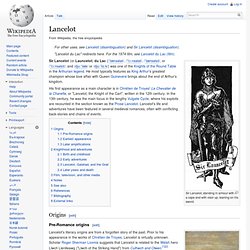
He most typically features as King Arthur's greatest champion whose love affair with Queen Guinevere brings about the end of Arthur's kingdom. Pellinore.
Questing Beast. Arthur and the Questing Beast.

The strange creature has the head and neck of a snake, the body of a leopard, the haunches of a lion and the feet of a hart.[1] Its name comes from the great noise it emits from its belly, a barking like "thirty couple hounds questing". 'Glatisant' is related to the French word glapissant, 'yelping' or 'barking', especially of small dogs or foxes. The questing beast is a variant of the mythological medieval view on giraffes, whose species name of Camelopardalis originated from their description of being half camel and half leopard.[2][3] Early accounts[edit] The first accounts of the beast are in the Perlesvaus and the Post-Vulgate Suite du Merlin.
Arthur sees the beast drinking from a pool just after he wakes from a disturbing dream that foretells Mordred's destruction of the realm (no noise of hounds from the belly is emitted while it is drinking). Other appearances[edit] Modern versions[edit] T. See Also[edit] Serpopard.